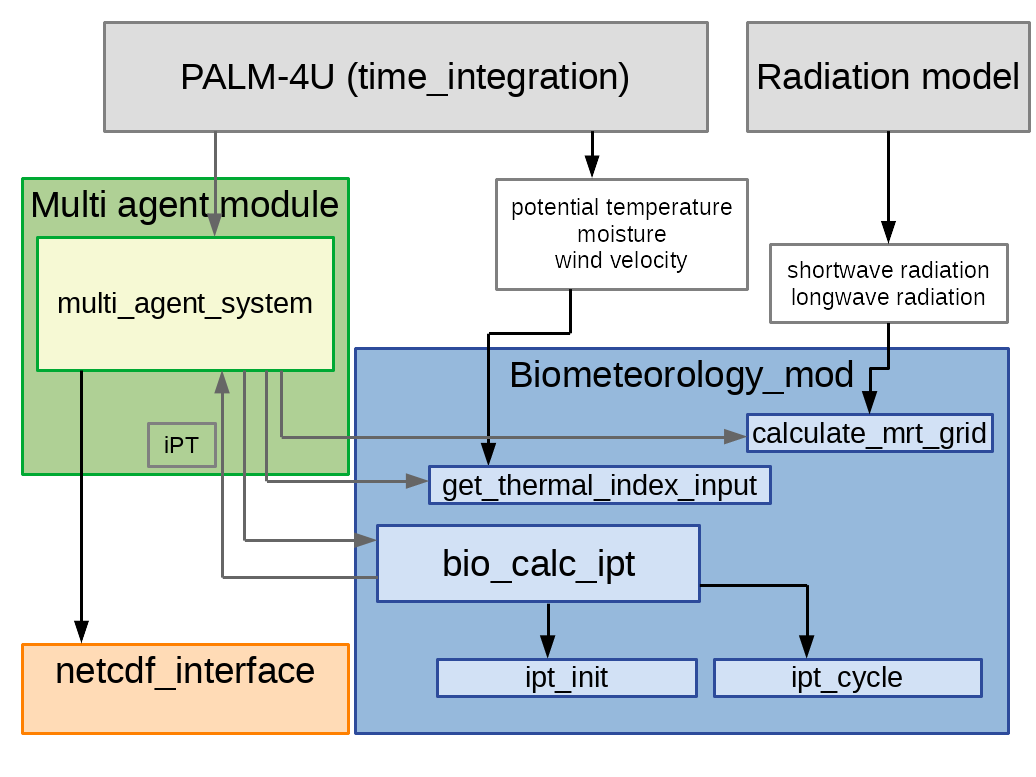Implementation
This page is part of the Human Thermal Comfort Module (HTCM) documentation. It contains the general structure of the thermal comfort part of the biometeorology module.
For an overview of all HTCM-related pages, see the HTCM main page.
Input data
Thermal comfort is estimated by the biometeorology module in terms of thermal indices. The three thermal indices
- Perceived Temperature (perct*)
- Universal Thermal Climate Index (utci*)
- Physiologically Equivalent Temperature (pet*)
are calculated based on the following input data provided by PALM:
- Potential Temperature (pt)
- Air humidity (q)
- Air current in u-, v-, and w-direction (u, v, w)
Additionally the radiation fluxes
- Shortwave radiation fluxes from and to the sample person (mrtinsw)
- Longwave radiation fluxes from and to the sample person (mrtinlw)
are required from the radiation model.
This basically holds for the static thermal indices (see above) as well as for the instationary index iPT. However, for iPT, the calculations are triggered by the agent module, additionally providing the position of the agent, the time elapsed, energy storage of the agent, as well as it's clothing temperature.
Integration
Thermal comfort maps
Calculations of the static indices (perct, utci, pet) by the thermal comfort part of the biometeorology module are triggered by time integration. For increased performance, thermal indices are only calculated for output timesteps.
In case of time-averaged thermal indices, the input quantities (see above) are averaged by the biometeorology module if PALM is not already averaging the same quantity itself. Thermal indices are, again, only calculated for the respective output timesteps to avoid unnecessary calculations.
Thermal comfort for agents
The thermal comfort calculations for the agent model in terms of the instationary thermal index iPT, however, is called and controlled by the agent module directly. As soon as a new agent is created, the agent module will make a first call to "bio_calc_ipt" passing personal information like age, weight, height, work and sex of the agent. "bio_calc_ipt" will thereby automatically detect that iPT is uninitialized and will run the method "ipt_init" to determine the activity and to initialize energy storage, as well as the clothing temperature.
Any further call will be directed to "ipt_cycle", that will update energy storage, clothing temperature, as well as the thermal sensation in terms of iPT based on the meteorological conditions at the agents locations and the elapsed time.
Attachments (3)
-
Flussdiagramm_HTCM_static_en2.pdf
(23.1 KB) -
added by dom_dwd_user 5 years ago.
Flowchart showing the function calls of the static thermal comfort part in the biometeorology module.
-
Flussdiagramm_HTCM_static_en2.png
(106.5 KB) -
added by dom_dwd_user 5 years ago.
Flowchart showing function calls for the static part of the human thermal comfort calculations within the biometeorology module.
-
Flussdiagramm_HTCM_dynamic_en2.png
(100.9 KB) -
added by dom_dwd_user 5 years ago.
Flowchart showing function calls for the dynamic part of the human thermal comfort calculations within the biometeorology module.
Download all attachments as: .zip


